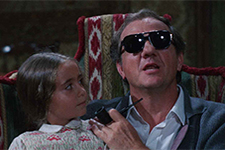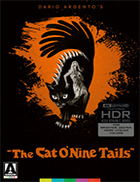The Cat O’ Nine Tails (Il gatto a nove code) (4K UHD)
|  After the international success of his directorial debut, The Bird With the Crystal Plumage (L’uccello dalle piume di cristallo, 1969), director Dario Argento returned to mine similar territory with his second effort, The Cat O’ Nine Tails (Il gatto a nove code), which stylishly evokes the Italian giallo mystery literary genre that began in the late 1920s, deriving its name from the signature yellow paperback editions in which they were published. Argento, with his penchant for aesthetic overkill, narrative ambiguity, and graphic violence, was always a natural fit for the lurid sex-and-violence-addled genre, and he honed his skills as a director with convoluted murder-mysteries that didn’t always demand coherence, linearity, or, most importantly, restraint. If The Cat O’ Nine Tails is his weakest early effort, it is only because he was still trying to find his voice, experimenting with different techniques and gradually learning just how far he could push the envelope. The story is based on the scientific concept—first published in several journals, magazines, and newspapers in the late 1960s and now recognized as erroneous—that men with XYY syndrome (meaning they have one extra Y chromosome) are predisposed to criminality. The plot centers around a late-night break-in at the Terzi Institute, where scientists are conducting high-profile genetic research. We see the break-in during the opening credits, but it is from the subjective perspective of the criminal; thus, although we see what happens, we don’t know the who and the why. The break-in becomes a point of interest for Franco Arno (Karl Malden), a former newspaper reporter who lost his sight 15 years earlier and now spends his time creating crossword puzzles and taking care of his young niece, Lori (Cinzia De Carolis), who calls him “Cookie” and acts as his eyes. Arno makes up for his lack of physical sight with both an unexplained “second sight” (he seems to “see” the break-in as it happens) and a deductive mind that causes him to ask just the right questions. Arno finds an unlikely ally in Carlo Giordani (James Franciscus), a gregarious newspaper reporter who may be physically striking, but lacks Arno’s intuition. Together they begin investigating the break-in and the subsequent murder of Dr. Calabresi (Carlo Alighiero), who Arno overheard the night of the break-in talking with someone about “blackmail.” The number of potential suspects is almost overwhelming. There is Dr. Calabresi’s fiancée Bianaca (Rada Rassimov); Dr. Baun (Horst Frank), a gay researcher at the institute who always seems to be hiding something; Dr. Casoni (Aldo Reggiani), a brilliant young researcher who blatantly tells Giordani that he knows things he will never reveal; and Anna Terzi (Catherine Spaak), the seductive daughter of the institute’s founder. The potential red herrings (of which there are arguably nine, hence the otherwise irrelevant title) pile up fast and high, and the convoluted nature of the unfolding plot is bested only by some of the more ridiculous implausibilities, such as a newspaper photographer not noticing that he was cropping out the hand and arm of the killer in his snapshot of a murder. The film benefits from the presence of Oscar-winner Karl Malden (A Streetcar Named Desire, On the Waterfront), who was certainly on the downside of his storied career by the early 1970s, but still makes for a sympathetic protagonist whose lack of sight does little to keep him from asserting his desire to solve the mystery. James Franciscus, on the other hand, who starred in the groundbreaking TV series Mr. Novack in the early 1960s and starred opposite Charlton Heston in Beneath the Planet of the Apes (1970), is the very definition of handsome blandness (a rarity for Argento, who tends to favor odd-looking men and beautiful women). Argento, who penned the script from a story idea he concocted with Luigi Collo and Dardano Sacchetti, has always leaned toward the ridiculous and the sublime, and the problem with The Cat O’ Nine Tails is that it never quite pushes its way into the absurd levels of hyperreal brilliance that have defined his best films such as Deep Red (Profondo rosso, 1975) and Suspiria (1977). There are a few high points, including a queasy sequence in which two characters must break into a crypt to retrieve an important piece of evidence and a grisly death in which a character falls down an elevator shaft and literally burns his hands trying to grab the cables on the way down. Argento also indulges in some effective black humor, especially a sequence in which Giordani is being shaved by a barber who is angry that the newspapers are suggesting the murderer might be a barber. The barber explicitly describes how he would slit someone’s throat while his blade comically flicks back and forth beneath the increasingly exasperated Giordani’s jaw. But, despite these stand-out setpieces, the film as a whole feels like a mixed bag. Perhaps because Argento was a young director still growing into his talents, the films feels like it’s trying to fit the conventional mold and failing at almost every turn. Seen in retrospect against his subsequent output, especially with its obsessive return to the ideas of “seeing” and “blindness,” it is clear that The Cat O’ Nine Tails is a nascent work in which Argento’s voice was just beginning to find its tone both thematically and visually. But, in and of itself, it is a somewhat clumsy mystery, burdened by too many unbelievable developments and random episodes and lacking the truly over-the-top theatrics to bind it all together.
Copyright © 2021 James Kendrick Thoughts? E-mail James Kendrick All images copyright © Arrow Video | |||||||||||||||||||||||||||||
Overall Rating: 

 (2.5)
(2.5)


